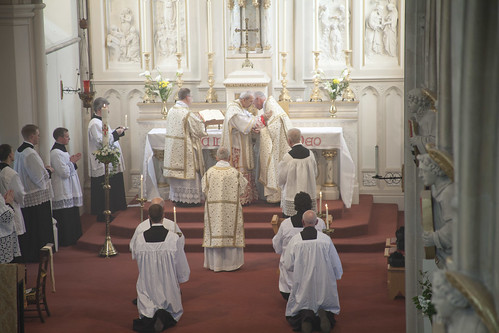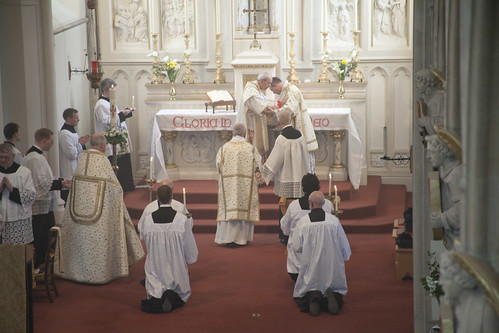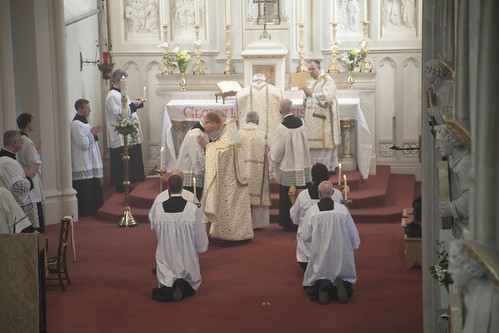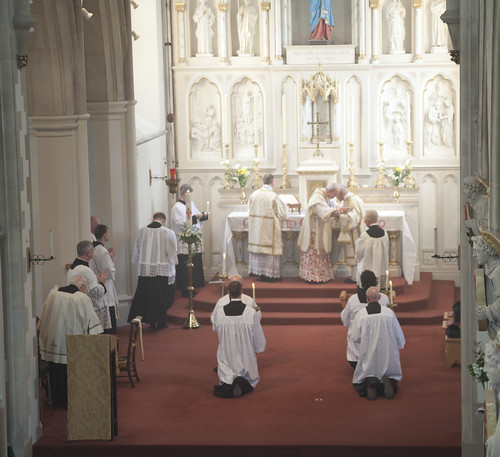 |
| Bishop Schneider giving the Kiss of Peace to Fr Finnegan, the Assistant Priest, at West Grinstead |
The Pax may not seem the most important issue, but it is an interesting one, and also one which has a big effect on many people's liturgical experience. The over-chumminess and disruption caused by the Novus Ordo's 'Sign of Peace' is a trial for many people, and has been repeatedly condemned by Rome, notably in Pope Benedict's Post-Synodal Exhortation Sacramentum Caritatis (2007) 49:
 |
| Bishop Schneider giving the Peace to Fr Goddard FSSP, the deacon |
‘…during the [2007] Synod of Bishops there was discussion about the appropriateness of greater restraint in this gesture, which can be exaggerated and cause a certain distraction in the assembly just before the reception of Communion. It should be kept in mind that nothing is lost when the sign of peace is marked by a sobriety which preserves the proper spirit of the celebration, as, for example, when it is restricted to one's immediate neighbours.’
Pope Benedict's words reflects the feelings of many, like those of a certain Mr Waits who felt moved to write the following to the Universe (UK Catholic weekly newspaper) in 2011:
Whoever dreamt up the sugary sign of peace seems to have been naively oblivious to some unpleasant practicalities. In my church, one elderly widower tours the pews 'making a meal'; of his license to to make contact with female bodies. ... When the 'feel good' moment arrives, they approach me expectactly, but I ignore such cheap, shallow, bonhomie. I have often felt like adding 'a little peace before Mass would not have gone amiss.'
The reform of this little ceremony exemplifies the 'archaeologism' of the reformers: their attempts, at least in some places, to resurrect long-extinct texts and rubrics. It also exemplifies the problems with such archaeologism: its dependence on the limited scholarship of half a century ago, its ability to miss the most crucial point about a ceremony, and its refusal to understand the good reasons why, under providence (not thanks so some know-it-all committee), change happened, gradually, over the course of the centuries.
 |
| The Assistant Priest giving the Peace to the Master of Ceremonies |
This is important for the meaning of the ceremony. At the Offertory, the key to it is the reconciliation of the Community, an idea which appealed to Bugnini and his gang in the 1960s. But in the Roman Rite, while this idea is not absent, there is something else which sets it into a bigger context.
The Peace is on the Altar.
Christ, the Prince of Peace, has come down upon the Altar, and it is His peace which is imparted in the Kiss. So it is not just exchanged between members of the congregation: it is given to them from Christ. The celebrant kisses the Altar next to the Consecrated Host, and it is this kiss, exchanged with Christ, which is passed on, one by one, to the rest of those present.
 |
| Bishop Schneider giving the Peace to Fr Hayward, the subdeacon |
The passing on of the Peace from the Altar has been completely lost in the current ceremony--if we can call it that--in the Novus Ordo, where everyone simultaneously shakes hands with everyone else.
Speaking personally, I am always moved to see the ceremony of the Pax at Traditional High Mass; I think it is one of the most symbolically eloquent ceremonies in the Mass. It is an example of something which really works. Those arguing about what to do about the Sign of Peace in the Novus Ordo should bear that in mind.
No comments:
Post a Comment